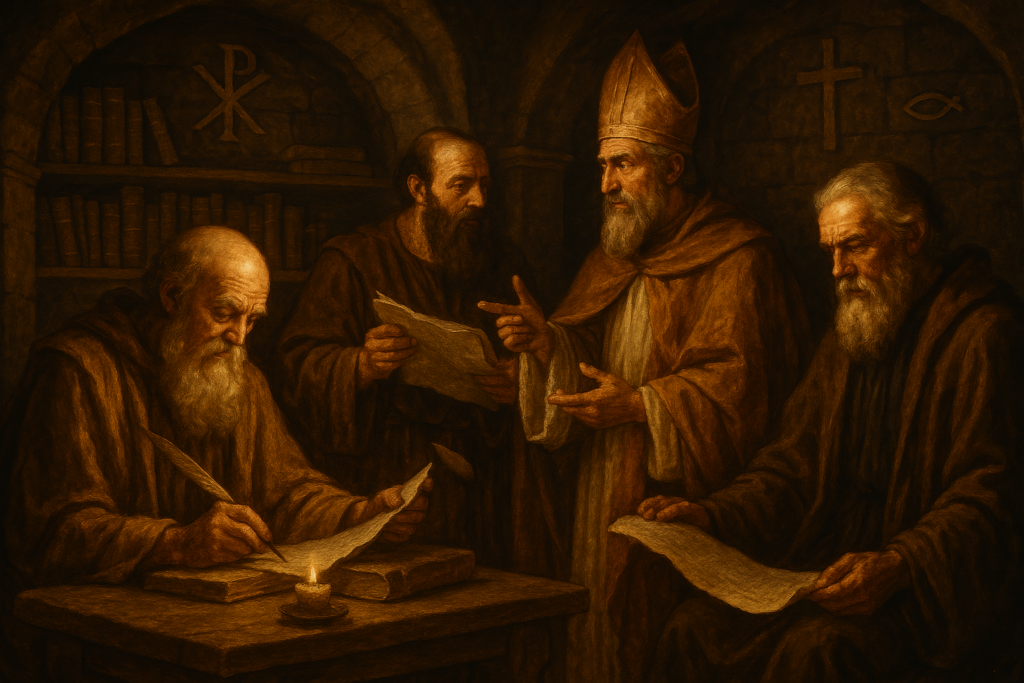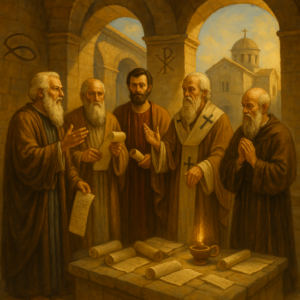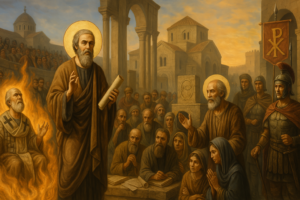
Estimated reading time: 15 minutes
Key Takeaways
- The early church fathers were foundational in shaping orthodox Christianity during its formative centuries.
- St. Justin Martyr’s apologetics bridged Greek philosophy and Christian truth, defending the faith in a hostile Roman world.
- Irenaeus’s writings against heresies safeguarded Christian doctrine from Gnostic distortions.
- Tertullian and Origen represent contrasting theological approaches that continue to influence Christian thought.
- Teachings of the early church fathers on Christian life offer practical guidance relevant for believers today.
Introduction to Early Church Fathers
The early church fathers were the formative teachers, leaders, and defenders of the Christian faith during the first few centuries after Christ. These influential voices shaped what would become orthodox Christianity during a time of persecution, political upheaval, and theological controversy. When we talk about early church fathers, we’re referring to those spiritual giants who stood in the gap between the apostolic age and the medieval church. They preserved, interpreted, and defended the teachings of Jesus and the apostles when Christianity was still a fledgling movement facing hostility from both Jewish and Roman authorities. Their contributions to the formation of Christian doctrine cannot be overstated. These men wrote extensively, debated vigorously, and in many cases, died willingly for beliefs that modern Christians often take for granted. In this exploration, we’ll discover how these ancient voices speak with surprising relevance to our modern world. From the Apostolic Fathers who personally knew the apostles to later theologians like Augustine, these spiritual ancestors have much to teach us about faith, doctrine, and Christian living today.Early Church Fathers History and Timeline
The history of the early church fathers spans roughly the first five centuries of Christianity, a period of remarkable growth and development for the faith. The earliest group, known as the Apostolic Fathers, lived between approximately 70-150 AD. These leaders had direct connections to the apostles themselves. Figures like Clement of Rome, Ignatius of Antioch, and Polycarp of Smyrna provide our first glimpse of post-biblical Christianity. Their writings help us understand how the earliest Christians interpreted apostolic teaching. Following the Apostolic Fathers came the Apologists (130-180 AD), who defended Christianity against philosophical attacks and government persecution. Justin Martyr exemplifies this group, using Greek philosophy to explain Christian concepts to a hostile Roman world. The third and fourth centuries saw the rise of systematic theologians who addressed complex doctrinal questions. Church fathers like Irenaeus, Tertullian, and Origen developed more comprehensive theological systems. A critical moment came with the Council of Nicaea in 325 AD. This first ecumenical council, convened by Emperor Constantine, addressed the Arian controversy regarding Christ’s divine nature. The resulting Nicene Creed, which affirmed Christ’s full divinity, remains a cornerstone of Christian orthodoxy today. The Post-Nicene period (325-451 AD) featured towering figures like Athanasius, the Cappadocian Fathers, John Chrysostom, and Augustine of Hippo. These theologians refined Christian thinking on the Trinity, Christ’s nature, biblical interpretation, and many other crucial topics. This rich history shows how Christian doctrine developed organically through thoughtful engagement with Scripture and tradition, not through arbitrary decisions of church authorities.St. Justin Martyr’s Apologetics
St. Justin Martyr (100-165 AD) stands as one of Christianity’s earliest and most important defenders. Born to pagan parents in Samaria (modern-day West Bank), Justin pursued philosophy extensively before encountering Christianity in his early thirties. What makes Justin remarkable is how he bridged Greek philosophy and Christian truth. As a convert trained in philosophical thinking, he used those same tools to defend the faith he came to embrace. Justin’s writings, particularly his First and Second Apologies and his Dialogue with Trypho, remain foundational works of Christian apologetics. In these documents, he:- Explained Christian worship practices to dispel rumors of cannibalism and immorality
- Described early Christian baptism and communion
- Argued that Christianity was the fulfillment of Greek philosophy, not its rejection
- Used Old Testament prophecies to demonstrate Jesus as the Messiah
- Defended Christians against charges of atheism and political disloyalty
Irenaeus Writings Against Heresies
Irenaeus of Lyons (130-202 AD) emerged as Christianity’s premier defender against false teaching during the second century. As bishop of Lugdunum (modern-day Lyon, France), he combated numerous theological threats, most notably Gnosticism. His masterwork, “Against Heresies” (Adversus Haereses), represents the most comprehensive response to early Christian heresies. This five-volume work methodically dismantled Gnostic teachings while articulating orthodox Christian beliefs. The Gnostics claimed to possess secret spiritual knowledge (gnosis) unavailable to ordinary Christians. They typically taught that:- The material world was evil, created by a lesser deity
- Christ only appeared to have a physical body
- Salvation came through secret knowledge rather than faith in Christ’s death and resurrection
- Apostolic succession – showing how orthodox teaching could be traced directly to the apostles
- The unity of God as both Creator and Redeemer
- The reality of Christ’s physical incarnation, death, and resurrection
- The public nature of true Christian teaching versus secret Gnostic “knowledge”
Tertullian and Origen’s Theological Contrasts
The early third century featured two theological giants whose contrasting approaches continue to shape Christian thought: Tertullian (155-220 AD) and Origen (185-254 AD). Tertullian, the fiery North African convert, became Christianity’s first major Latin writer. His legal background equipped him with precise language and argumentative skill. Famous for asking, “What has Athens to do with Jerusalem?”, Tertullian viewed Greek philosophy with suspicion, prioritizing revelation over reason. His contributions to Christian vocabulary were enormous. Tertullian coined terms like “Trinity” (trinitas) and developed the language of “three persons, one substance” that would later shape Trinitarian orthodoxy. Despite his theological brilliance, he eventually joined the Montanist movement, which emphasized prophetic gifts and rigorous morality, placing him at odds with more mainstream Christianity. In striking contrast, Origen of Alexandria embraced Greek philosophy as a tool for understanding Scripture. An extraordinarily prolific writer (producing reportedly 2,000 works), Origen pioneered allegorical biblical interpretation and developed the first systematic Christian theology. His most controversial ideas included:- The pre-existence of souls
- The eventual salvation of all beings (including Satan)
- A spiritual rather than physical resurrection
Polycarp of Smyrna Martyrdom
Polycarp of Smyrna (69-155 AD) provides one of the most direct connections to the apostolic age. As a disciple of John the Apostle and bishop of Smyrna (modern Izmir, Turkey), Polycarp bridges the gap between the New Testament era and the developing church. While his surviving writings are limited to a single letter to the Philippians, Polycarp’s greatest legacy comes through his martyrdom, recorded in the document “The Martyrdom of Polycarp” – the earliest detailed account of a Christian martyr’s death outside the New Testament. At approximately 86 years old, Polycarp was arrested during a wave of persecution. When commanded to renounce Christ and swear by the emperor’s genius, he famously replied: “Eighty-six years I have served Him, and He has done me no wrong. How can I blaspheme my King who saved me?” The account of his execution is both moving and historically significant:- He prayed extensively before his death, thanking God for counting him worthy to be a martyr
- He was burned at the stake when officials learned he could not be intimidated
- Witnesses reported the flames formed a canopy around him without burning his body
- He was finally killed by a dagger when the fire failed to consume him
- Christians gathered his bones as precious relics
- The apostles (especially John)
- His own generation (including Ignatius of Antioch)
- His disciples (including Irenaeus)
Ignatius of Antioch Writings on Church Unity
Ignatius of Antioch (35-110 AD) stands among the most important Apostolic Fathers. As the third bishop of Antioch (after Peter and Evodius), Ignatius wrote seven remarkable letters while being transported to Rome for execution. These writings provide an unparalleled window into early church structure and theology, particularly regarding church unity. Ignatius believed unity was essential for the church’s survival and witness in a hostile world. His letters emphasize several key themes:- Episcopal authority: “Do nothing without the bishop” appears repeatedly in his writings. Ignatius saw the bishop as Christ’s representative, with presbyters (elders) corresponding to apostles and deacons serving both.
- Eucharistic unity: “Take care to participate in one Eucharist, for there is one flesh of our Lord Jesus Christ and one cup to unite us with His blood, and one altar, just as there is one bishop…”
- Protection against heresy: Ignatius warned against docetic heretics who denied Christ’s physical body. He insisted, “He [Christ] was truly born, truly lived, truly ate and drank, was truly crucified and died…”
- Martyrdom as witness: Anticipating his own death, Ignatius viewed martyrdom as the ultimate imitation of Christ. “I am God’s wheat, ground by the teeth of wild beasts to become pure bread for Christ.”
Early Church Fathers Teachings on Christian Life
The early church fathers provide remarkably practical guidance for Christian living that remains relevant today. Their teachings emerged from communities facing hostility and persecution, making their advice particularly valuable for believers navigating challenging cultural environments. The Apostolic Fathers’ writings focused extensively on practical Christian ethics. The Didache, one of the earliest Christian documents outside Scripture (c. 70-100 AD), provided straightforward moral instruction: “There are two ways: one of life and one of death, and the difference between these two ways is great.” It then outlined behaviors consistent with the “way of life” (compassion, honesty, sexual purity) versus the “way of death” (murder, theft, idolatry). The early fathers emphasized several key areas of Christian living:- Prayer and fasting: Clement of Alexandria recommended praying three times daily and described fasting not as deprivation but as “abstinence from evils.” Early Christians regularly fasted on Wednesdays and Fridays.
- Sexual ethics: In a culture of widespread sexual exploitation, the fathers advocated marital fidelity and sexual restraint. Tertullian observed that Christians were “marked by the same purity of behavior” whether married or single.
- Care for the vulnerable: Justin Martyr described how Christians pooled resources to help “orphans and widows, those who are in want because of disease or any other cause.” This communal care deeply impressed Roman observers.
- Attitude toward wealth: The Shepherd of Hermas warned, “It is hard for the rich to enter the kingdom of God,” while encouraging generosity: “Therefore, instead of fields, buy souls in trouble according to your means.”
- Approach to persecution: Ignatius urged Christians to pray for persecutors rather than retaliate, writing, “Be gentle when they are angry, humble when they are boastful.”



